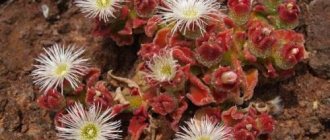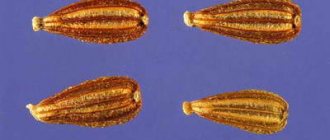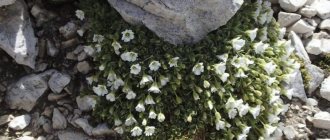Author: Elena N. https://floristics.info/ru/index.php?option=com_contact&view=contact&id=19 Category: Garden plants Published: February 09, 2019Last edits: January 20, 2021
- When to plant
- Growing conditions
- How and when to collect seeds
- Clarkia graceful, or marigold (Clarkia unguiculata = Clarkia elegans)
Clarkia is a charming flowering annual, an elegant and beautiful plant, closely related to godetia. Clarkia seeds germinate well, seedlings grow very quickly, and flowering lasts about three months. Clarkia is represented by many species and varieties of different colors, including those with double flowers, which are located on the peduncles so densely that the leaves are almost invisible because of them.
Our article contains information about:
- what varieties of clarkia are the most popular;
- how to sow clarkia seedlings;
- when and how to transplant seedlings into a flower garden;
- how to care for the plant during the season;
- how to collect clarkia seeds.
Planting and caring for clarkia
- Planting: sowing seeds in the ground - in April or early May, you can, but sow them before winter; sowing seeds for seedlings - in March, transplanting seedlings into the ground - in the second or third ten days of May.
- Lighting: bright sunlight.
- Soil: loose, light, dry, fertile, slightly acidic soil. Oily soil is not suitable for the plant.
- Watering: only during drought - twice a week.
- Feeding: during the periods of budding and flowering, once every two weeks with complex mineral fertilizer.
- Reproduction: seed.
- Pests: mealybugs, garden flea beetles.
- Diseases: rust.
Read more about growing clarkia below.
flowers (lat. Clarkia) are a genus of annual herbs of the fireweed family, close to Godetia, which some botanists combine with Clarkia into one genus. The plant is named after the captain named William Clark who brought it from California to Europe in the 19th century. In nature, the clarkia flower grows in the west of North America and Chile and has more than 30 species, of which only three are of interest to gardeners.
What diseases do they face?
This plant is quite resistant and invulnerable to disease. But if there are errors in care or cultivation, certain diseases may develop. If the bush is planted on loamy soil, this can provoke the development of rust. This fungal disease also appears when liquid stagnates in the soil. To get rid of rust, fungicidal preparations are used.
If there is stagnation of moisture in the roots, downy mildew may develop. In this case, fungicides are used to treat the plant.
Botanical description
So, the clarkia plant is an annual herbaceous crop, reaching a height of 30 to 90 cm. The stems of clarkia are branched, erect, usually pubescent with short villi. Elongated oval sessile leaves of bright green or bluish color are arranged alternately. Simple or double axillary flowers of regular shape with a diameter of up to 3.5 cm, painted in different colors, usually collected in spike-shaped or racemose apical inflorescences, but occasionally a single arrangement of flowers is found. The calyx of the flower is tubular, the corolla consists of four whole or three-lobed flowers, which taper at the base into a marigold. The fruit of clarkia is an elongated polysperm.
- Tips for growing gladioli in a flower bed (video)
Features of cleome
Cleome has a very powerful root system. Branched strong shoots, on their surface there is pubescence consisting of short glandular hairs. The height of the bush can reach up to 150 cm. The greenish alternate leaf plates of some species have small spines on the underside. Leaves can be simple or complex: they consist of 5 or 7 entire elongated linear leaflets. The apical leaf blades are small and entire. The apical racemose inflorescences consist of flowers that have a regular shape and are purple, pink, white or yellow in color. The flowers have relatively long stamens that look like spider legs. The fruit is a unilocular polysperm, pod-shaped, and can reach about 30 mm in length. Most amateur gardeners do not like the floral smell of cleome, but in an outdoor garden it is completely impossible to smell it, but it can repel pests. This unusual aroma is necessary for such a flower to attract small bats in the wild, which are its pollinators.
Flowers bloom beautifully for the garden. Cleome from seed to flowering!
Watch this video on YouTube
Growing clarkia from seeds
How to sow seeds
Clarkia flowers are grown by seed - seedlings or non-seedlings. With the seedless method, clarkia seeds are sown directly into the ground. This can be done in April or early May, as well as in late autumn, before winter. Before sowing clarkia, add 1 kg of peat per m² and a tablespoon of potassium sulfate with superphosphate to the area to be dug, and a tablespoon of each for the same area. You need to dig up the area with fertilizers at least two weeks before sowing.
Small clarkia seeds are sown in nests of 4-5 pieces at a distance of 20-40 cm, but are not buried in the ground, but lightly pressed onto it and sprinkled with the thinnest layer of soil. Shoots may appear in as little as two weeks, and you will have to thin them out, but don’t get carried away—clarkia blooming in a dense bush looks more beautiful. When planted in autumn, the seedlings have time to germinate before the onset of winter and are preserved well under the snow, but even if the crops do not germinate, there is nothing to worry about. In the spring, when Clarkia sprouts, you only need to thin it out, like carrots.
Seedling care
Clarkia from seeds, grown by seedlings, at the very beginning of its life is reliably protected from temperature changes, frosts, cold spring rains and other seasonal and climatic troubles, which is why many flower lovers prefer to grow seedlings rather than sow flowers directly into the ground. Clarkia seeds are sown for seedlings in March, then it will bloom in early June.
Sow the seeds in slightly acidic soil, press them down with a board, sprinkle them with water, cover with glass and place in a bright, warm place out of direct sunlight. As soon as the shoots appear, the glass can be removed, but the container with the crops should remain in a dry, warm place with good ventilation until planting in open ground. Clarkia should be picked as early as possible - as soon as the seedlings have their first leaves.
Sowing
Before sowing calla lilies, you need to germinate the seeds. To do this, they are placed in warm water for 6 hours. Adding a growth stimulator will not be superfluous. After this, the planting material is placed in a damp towel or gauze, covered with it and sent into a warm place for about a week. When the towel begins to dry out, you will need to re-moisten it.
Seeds are planted as follows. Small holes are made in the previously prepared soil, about 3 centimeters deep. The soil is watered, seeds are placed in it and carefully sprinkled on top. If clay pots are used, the number of seeds in each should be from 3 to 5, this will guarantee the emergence of seedlings.
Planting clarkia in open ground
When to plant
Clarkia flowers are planted in open ground in May. If the soil on your site is not suitable for clarkia due to its pH value, there are several ways to acidify it: add one to one and a half kilograms of peat or 60 g of sulfur per square meter to the soil for digging, or spill the soil with a solution of oxalic or citric acid at the rate 1.5 tablespoons per 10 liters of water. If the soil is too acidic, it is limed before planting the clarkia, and if it is too oily, the area is dug up with sand. Well, don’t forget to add fertilizers, which have already been mentioned. You need to prepare the area for Clarkia at least two weeks before planting.
How to plant
Clarkia is planted in this way: seedlings are taken out of the container not one at a time, but in groups, together with a lump of earth, and also planted in holes located at a distance of 20 to 40 cm from each other. Near each hole you need to stick a stick or a rod, which will serve as a support for the thin stems of the clarkia when the bushes grow. Plant different varieties of plants at a distance from each other, because they can cross-pollinate with each other. After planting, the plants are watered and lightly pinched to stimulate tillering.
- Strawberries: diseases and pests and their control
How is it different from godetia?
Clarkia is very similar to godetia, the similarity is so strong that some botanists even considered these crops to be a variety of the same plant for a long time. However, these are different cultures.
Claricia's flowers are small, looking like miniature roses, as if strung on twig stems. Godetia's flowers are quite large, elegant, satiny - each size is 6-8 cm, they can be double or simple. Both cultures can have a wide variety of shades: white, pink, as well as scarlet, purple, lilac and bluish.
The height of the bush also varies. Clarkia grows up to 30–90 cm, while the length of the Godetia stem does not exceed 30–40 cm.
Despite their differences, gardeners often plant these plants together. They claim that the cultures harmoniously complement each other in the flowerbed.
Clarkia care
Growing conditions
Growing clarkia and caring for it will not require any special knowledge or effort from you. The plant only needs to be watered twice a week during dry periods, and the rest of the time, rain moisture will suffice for Clarkia. For irrigation, you need enough water so that it is quickly absorbed and does not stand in a puddle around the plant.
During the periods of budding and flowering, Clarkia is fed with complex mineral fertilizers once every two weeks. Kemira or Rainbow are suitable for this purpose; Clarkia is not fertilized with organic matter. Remove faded flowers and seed pods so that the plant spends its energy only on the formation of new buds. That's all there is to caring for Clarkia.
Pests and diseases
Of the insect pests, clarkia is affected by the mealybug, traces of whose vital activity look like a cotton wool-like waxy coating on the ground parts of plants. Mealybugs are combated by spraying with Aktara, Confidor or Fitoverm.
If the soil in the area with clarkia is loamy, this may cause a fungal disease, manifested by rusty-yellow spots with a brown border on the leaves. To destroy the fungus, the plant is sprayed with fungicides - Bordeaux mixture or oxychome, for example. In general, Clarkia is a very resistant plant to pests and diseases, and if you properly prepare the soil for it, neither it nor you will have problems with it.
How to properly care?
In order for Clarkia to delight you with its healthy and lush flowering for a long time, you need to follow simple rules for caring for this plant.
Watering
In hot summer weather without heavy rainfall, clarkia requires regular moderate watering as the soil dries out - usually twice a week. However, keep in mind that under no circumstances should the plant be flooded, otherwise the roots will begin to rot. In order to prevent this unpleasant phenomenon, it is best to plant the crop in well-drained soil.
The wet substrate should be loosened a little - this improves the flow of air to the roots.
Water must be poured directly under the bush, avoiding liquid getting on the leaves and flowers, otherwise burns may appear on them under the rays of the sun.
Fertilizer
Clarkia should be fertilized twice a month, especially during the budding and flowering stages. It is best to use ready-made mineral complex compositions, which can be purchased at any store.
This plant especially needs feeding in dry, rainy weather. In order to achieve more luxuriant flowering, you can add a little crushed wood ash to the ground.
Trimming
In order for flowering to be longer and more spectacular, all fading inflorescences must be removed in a timely manner, otherwise the plant simply will not have the vitality left to produce new flower stalks.
The same goes for fading dried stems, shoots and branches.
Collection of seed material
Clarkia tends to reproduce by self-sowing, so even at the moment of flowering you need to select 3-4 large flowers, after pollination, wilting and at the very beginning of the formation of the fruit, you should “isolate” it. To do this, wrap the fruit with a clean bandage and fix it to the stem, but not too tightly. Thus, the seeds ripen, but the gauze prevents them from scattering - this eliminates the risk of self-sowing.
After the flower withers, the seed material ripens for about a month, the finished boxes look dark brown, they need to be collected and dried naturally, and then placed for storage in paper envelopes or matchboxes.
Wintering
Clarkia is characterized by high resistance to frost, however, when planting in autumn, in order for the flower to be better preserved, it must be covered with mulch (you can use moss, fallen leaves, hay or pine needles).
In all other cases, you simply need to cut off all parts of the bush in the fall and dig up the roots in order to prevent the development of fungal infections in the ground.
Clarkia after flowering
How and when to collect seeds
Actually, Clarkia reproduces well by self-sowing; you just need to carefully thin it out in the spring, when the bristles of Clarkia seedlings appear. But if you still decide to collect the seeds, then doing it couldn’t be easier: select several beautiful flowers during flowering and, when they begin to fade, tie them with gauze so that the seeds, when ripe, do not fall to the ground. The seeds ripen a month after the end of flowering, when the capsule turns brown. Cut off the seed pod, sprinkle it on newspaper, dry it and sow it before winter or store it in a paper bag until spring.
Clarkia in winter
After the clarkia has finished blooming, it can be cut back to the ground, and when it comes time to dig up the area, remove the remains of the clarkia and destroy them. It is best to burn them to prevent the development of pathogenic bacteria and fungi in them, which can infect the soil or healthy plants.
Soil requirements
For active growth and development of clarkia, a loose, fertile, light soil substrate is required. The plant is unpretentious to the density and composition of the soil. But on dense clay soil its development slows down, and flowering will be poor.
The optimal soil substrate is a mixture of the following components:
- garden soil;
- rotted mullein;
- peat;
- sand.
Before planting the seeds of Clarkia graceata, they must be baked in the oven. This is an excellent prevention of fungal diseases.
Types and varieties
As already mentioned, only three types of clarkia are grown in garden culture: clarkia marigold, or clarkia graceful; pretty clarkia, or pubescent clarkia; Clarkia Brevery.
- Lily bulbs
Clarkia graceful, or marigold (Clarkia unguiculata = Clarkia elegans)
The Clarkia graceful flower grows wild in California. It is a branched, dense annual up to a meter high. Its stems are strong, thin, woody in the lower part, the leaves are oval, bluish-green with red veins, unevenly sparsely toothed along the edges. Regular flowers up to 4 cm in diameter, simple or double, white, red, purple, pink or blue, are located one at a time in the leaf axils. Small seeds remain viable for up to 4 years. Blooms profusely from July to September. Growing Clarkia elegans is very common in our climate. Popular varieties:
- Albatross - terry clarkia white, the height of the branched bush is about 75 cm;
- Purpurkenig - a double variety of carmine color, flowers with a diameter of 3.5-4 cm, bush height 80-90 cm;
- Salmon perfection - double, salmon-pink flowers up to 3.5 cm in diameter, loose bush up to 90 cm high.
Clarkia pulchella
The plant is dwarf. Its stems are branched, erect, up to 40 cm tall. The leaves are green, long, narrow, entire, pointed towards the apex and tapered towards the petiole. The flowers are simple or double, solitary or collected in several pieces in the axils of the leaves on the tops of the shoots. The shape of the petals, divided into three widely spaced lobes, is original, which is why the Americans nicknamed this species “moose horns.” It blooms two weeks earlier than the graceful clarkia.
Clarkia breweri
For some time now, the species Clarkia Breveri has been gaining popularity - a cold-resistant annual up to 50 cm high. The butterfly-like flowers, up to 3 cm in diameter, forming loose inflorescences, have a strong and pleasant aroma. Varieties:
- Pink Ribbons is a variety with pink flowers, the petals of which resemble ribbons, the height of the bush is only 30 cm, the stems are branched, the flowering is abundant.
All the other Clarkia species you've heard or read about are actually members of the genus Godetia.
Mix of colors
The mixture of crop colors directly depends on the plant variety. There are different shades - purple, blue, red. There are also white and pink varieties.
Charm
This mixture has an attractive appearance. The plant is decorated with flowers of different pink shades.
Sakura
This variety is characterized by delicate flowers that appear in July. The plant has double inflorescences of a peach hue. They adorn the tall branched stem. Culture is used to form group compositions. It can also be used to create tall, beautiful bouquets.
Varietal varieties
Like many other ornamental plants, the clarkia flower is represented by a huge variety of varieties with petals of various shades.
We will consider only the most popular types of crops and describe the varietal characteristics of each of them, so that you can create an original color composition for your own garden (Figure 2). Popular varieties of clarkia graceful include:
- Terry: a relatively low variety, the height of its shoots rarely exceeds 65 cm. The bush is quite branched, covered with dark green leaves. During the flowering period, buds 5-6 cm in diameter, with double petals, bloom on the branches. The color of the inflorescences can vary from white to deep red.
- “Fantasy”: this annual plant with lush inflorescences is highly decorative. The length of the shoots can reach 75 cm, and during the flowering period they are abundantly covered with relatively large double inflorescences. A distinctive feature of the variety is the variety of colors of the petals. In addition, this subspecies can be used not only in group and single plantings, but also for cutting.
- Clarkia is pretty: a very unusual variety, which differs from others in its short stature and original shape of inflorescences. The height of the plant is 20-40 cm, the leaves are thin and pointed, and the flowers can be double or simple. The variety is also distinguished by its early onset of flowering: the first buds bloom 2-3 weeks earlier than representatives of other subspecies.
- “Joy”: a densely branched variety with a shoot height of 40-60 cm. A distinctive feature is that flowering begins two months after sowing the seeds. The petals can have different colors: from rich pink to crimson.
Figure 2. The best varieties of the crop: 1- Terry, 2 - Fantasy, 3 - Pretty, 4 - Joy
Each of these varieties is good on its own, but the flowerbed will look much more impressive if you combine several types of clarkia at once. In addition, many of the described subspecies served as the basis for the creation of hybrids, which are also highly decorative.











